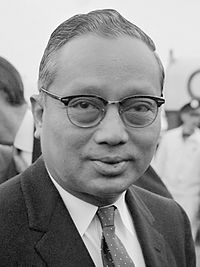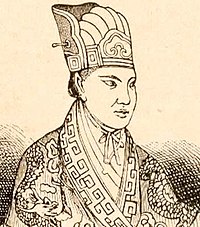Politics of Orioni: Difference between revisions
m (→Chairperson) |
m (→Chairperson: more pictures) |
||
| Line 78: | Line 78: | ||
| [[File:Man_Silhouette2.jpg|80px]] || Mr/s $Name<br/>{{small|(1883-1960)}} || 1955 || 1959 || $Party || $Year(s) || $Credit(s) | | [[File:Man_Silhouette2.jpg|80px]] || Mr/s $Name<br/>{{small|(1883-1960)}} || 1955 || 1959 || $Party || $Year(s) || $Credit(s) | ||
|- | |- | ||
| [[File: | | [[File:Queen Sirikit 1960.jpg|80px]] || Mr/s $Name<br/>{{small|(1896-1987)}} || 1959 || 1963 || $Party || $Year(s) || $Credit(s) | ||
|- | |- | ||
| [[File: | | [[File:Esperanza Osmena (Malacanang photo).jpg|80px]] || Mr/s $Name<br/>{{small|(1901-1975)}} || 1963 || 1967 || $Party || $Year(s) || $Credit(s) | ||
|- | |- | ||
| [[File:Sydykbekov_Tugelbay.JPG|80px]] || Mrs {{wp|Tugelbay Sydykbekov|Yekirigizi Sinetsihufi}}<br/>{{small|(1912-1997)}} || 1967 || 1975 || style="background:red"|{{color|white|WPO}} || 1971<br/>1975 || Recovery from [[Second Argic War]] | | [[File:Sydykbekov_Tugelbay.JPG|80px]] || Mrs {{wp|Tugelbay Sydykbekov|Yekirigizi Sinetsihufi}}<br/>{{small|(1912-1997)}} || 1967 || 1975 || style="background:red"|{{color|white|WPO}} || 1971<br/>1975 || Recovery from [[Second Argic War]] | ||
|- | |- | ||
| [[File: | | [[File:Begum Fazilatunnesa.jpg|80px]] || Mr/s $Name<br/>{{small|(1907-1988)}} || 1975 || 1979 || $Party || $Year(s) || Recovery from economic crisis | ||
|- | |- | ||
| [[File: | | [[File:Usha Narayanan.jpg|80px]] || Mrs Beza Menkir Alem<br/>{{small|(1911-2004)}} || 1979 || 1983 || $Party || $Year(s) || $Credit(s) | ||
|- | |- | ||
| [[File: | | [[File:Mae Jemison 2013.jpg|80px]] || Mrs [[Eleni Arame]]<br/>{{small|(1918-2019)}} || 1983 || 1987 || $Party || $Year(s) || $Credit(s) | ||
|- | |- | ||
| [[File:U_Thant_(1963).jpg|80px]] || Mr [[Hano Ketenya]]<br/>{{small|(1924-2020)}} || 1987 || 1991 || style="background:red"|{{color|white|WPO}} || $Year(s) || $Credit(s) | | [[File:U_Thant_(1963).jpg|80px]] || Mr [[Hano Ketenya]]<br/>{{small|(1924-2020)}} || 1987 || 1991 || style="background:red"|{{color|white|WPO}} || $Year(s) || $Credit(s) | ||
|- | |- | ||
| [[File: | | [[File:Mae Jemison 2013.jpg|80px]] || Mrs [[Eleni Arame]]<br/>{{small|(1919-2007)}} || 1991 || 1995 || $Party || $Year(s) || $Credit(s) | ||
|- | |- | ||
| [[File: | | [[File:Jaya (Singer).jpg|80px]] || Mrs [[Salayish Ciris]]<br/>{{small|(1937-)}} || 1995 || 2003 || style="background:blue"|{{color|white|Blueropa}} || $Year(s) || Infrastructure projects<ref>[https://www.europans.com/topic/4030-reopening-international-relations/?do=findComment&comment=22054792 Bullet train from O'polis to Zuidhaven] (15 February 2016)</ref> | ||
|- | |- | ||
| [[File:Isabella_Rossellini_Cannes_2015.jpg|80px]] || Mrs [[Chandra Pristo]]<br/>{{small|(1952-)}} || 2003 || 2007 || style="background:red"|{{color|white|SP.O}} || 2003<br/>2015 || Establishment of [[Entente of Oriental States]] | | [[File:Isabella_Rossellini_Cannes_2015.jpg|80px]] || Mrs [[Chandra Pristo]]<br/>{{small|(1952-)}} || 2003 || 2007 || style="background:red"|{{color|white|SP.O}} || 2003<br/>2015 || Establishment of [[Entente of Oriental States]] | ||
Revision as of 00:02, 8 October 2021
Politics of Orioni Erwaniye poletika | |
|---|---|
 | |
| Polity type | Unitary parliamentary constitutional monarchy |
| Constitution | Constitution of Orioni |
| Legislative branch | |
| Name | Sibiseba |
| Type | Unicameral |
| Appointer | Direct election |
| Executive branch | |
| Head of State | |
| Title | Empress |
| Currently | Joni I Nabérrie |
| Head of Government | |
| Title | Chairlady |
| Currently | Chandra Pristo |
| Cabinet | |
| Name | Imperial Council |
| Current cabinet | Pristo II |
| Ministries | 12 |
| Judicial branch | |
| Name | Judiciary of Orioni |
The politics of Orioni take place with the framework of a parliamentary democracy under a constitutional monarchy in which the monarch, currently Empress Joni, is the head of state while the Chairperson of the Memakiriti, currently Chandra Pristo, is the head of government. Orioni has been described as a bureaucratic monarchy where legally the power lies in the hands of the monarch but the real power lies in the hands of the bureaucracies surrounding her. The Orinese Constitution provides for a separation of powers. The political system of Orioni consists of an executive branch, a legislative branch, and a judicial branch.
Executive power is exercised by the Chairperson of the Imperial Council (Oharic: Memakiriti). The Government consists of the Chairperson and councillors. The government, including the Chairperson, can be revoked by the Sibiseba.
The Sibiseba (Anglish: Assembly) passes statutes and votes on the budget; it controls the action of the executive through formal questioning on the floor of the houses of Sibiseba and by establishing commissions of inquiry. The Orinese political system is a multi-party system. Former executive leaders are members of the Sibiseba.
The judiciary is based upon civil law system and is independent of the executive and the legislature. The highest court is the Imperial Court of Orioni.
History
An early executive branch was the Imperial Council (Oharic: Memakiriti). At its creation in 1175, it was composed of four councillors or advisors, with the monarch representiving the fifth decisive vote. The position of "Councillor" (abbreviated as Cllr) was appropriated from city government and carried over to the national level. The title precedes the holder's other titles, for example Cllr Andrew Pipkin. Each councillor was the head of a specialized department and a geographical area of expertise (several provinces). The Empress would open her personal correspondence and discuss hearings only in the presence of at least 2 councillors. They gave council to the empress, and confirmed (or co-signed) and accelerate royal decisions (edicts and declarations). These four departments were:
- Councillor of the Imperial Household: oversaw the royal entourage, clergy, affairs of the capital, royal buildings, and personal military guard.
- Assisted by the Keeper of the Seals.
- Councillor of War: First Officer of the Crown, highest commander of the army, oversaw border provinces.
- Assisted by the Master of the Horse.
- Councillor of the Navy: highest commander of the navy, oversaw colonial matters.
- Assisted by the Admiral of the Galleys.
- Councillor of Mediation: oversaw diplomacy, foreign relations and trade.
- Assisted by the Collector of the Tithe.
The Council was considered a very important body of government. The various councillors were still subject to the crown. Some historians even consider it to be more important than the Monarchy itself.[citation needed]
In 1195 new laws were introduced to celebrate 20 years of restoration. An early legislative branch was formed as part of the constitutional law reforms, transforming the monarchy into a more deliberative form. The Gizatochi was an early precursor to the Sibiseba. This institutionalised assembly critiqued monarchical decisions, discussed laws about taxes, trade, diplomacy, and military matters. It was a select committee that included fifty noble representatives from the Tamanyi cities. This was expanded in later centuries to include representatives from. However, colonial posessions were not represented.
Monarchy
National government
Executive
The executive branch is lead by the Chairperson, supported by councillors. The Chairperson is the head of government, elected by the legislative Sibiseba. In Orinese politics the Chairperson is equivalent to that of a prime minister. S/he heads the imperial council and lead of the councillors in the executive branch of government. The councillors are responsible for heading a government department.
Chairperson
| Portrait | Name (Birth–Death) |
Took office | Left office | Political party | Elected | Notable credit(s) |
|---|---|---|---|---|---|---|
 |
Mrs Lusiya Selami ina Gitiri (1878-1967) |
1951 | 1955 | $Party | $Year(s) | Establishment of Europan Commercial Alliance |
 |
Mr/s $Name (1883-1960) |
1955 | 1959 | $Party | $Year(s) | $Credit(s) |
 |
Mr/s $Name (1896-1987) |
1959 | 1963 | $Party | $Year(s) | $Credit(s) |
 |
Mr/s $Name (1901-1975) |
1963 | 1967 | $Party | $Year(s) | $Credit(s) |
 |
Mrs Yekirigizi Sinetsihufi (1912-1997) |
1967 | 1975 | WPO | 1971 1975 |
Recovery from Second Argic War |
| File:Begum Fazilatunnesa.jpg | Mr/s $Name (1907-1988) |
1975 | 1979 | $Party | $Year(s) | Recovery from economic crisis |
 |
Mrs Beza Menkir Alem (1911-2004) |
1979 | 1983 | $Party | $Year(s) | $Credit(s) |
 |
Mrs Eleni Arame (1918-2019) |
1983 | 1987 | $Party | $Year(s) | $Credit(s) |
 |
Mr Hano Ketenya (1924-2020) |
1987 | 1991 | WPO | $Year(s) | $Credit(s) |
 |
Mrs Eleni Arame (1919-2007) |
1991 | 1995 | $Party | $Year(s) | $Credit(s) |
 |
Mrs Salayish Ciris (1937-) |
1995 | 2003 | Blueropa | $Year(s) | Infrastructure projects[1] |
 |
Mrs Chandra Pristo (1952-) |
2003 | 2007 | SP.O | 2003 2015 |
Establishment of Entente of Oriental States |
 |
Mr Ionas Strupar (1970-2016) |
2007 | 2015 | PO&N | 2007 2011 |
Various military projects[2] |
 |
Mrs Chandra Pristo (1952-) |
2015 | 2019 | SP.O | 2003 2015 |
Financial recovery; hosting the 2018 UENA World Cup; Green Shift; STEM grants; Strategic petroleum reserves[3] |
 |
Ms Awidefale Rezovi (1975-) |
2019 | Present | SP.O | 2019 | Bainbridge Islands peacekeeping; 5G rollout |
Legislative

The Sibiseba (Anglish: "assembly") is the unicameral legislative body of Orioni. In 2021 there are 162 sibisebali, elected to a four-year term. 82 seats are required for a majority.
- Orinese nationals aged 18 years and older may vote. Prior to 1991, the voting age was 20.
- Orinese nationals aged 25 years and older may run for office in the Sibiseba.
Judicial
Based on the ancient Aroman system of αλήθεια (alítheia, truth).
- Palace of Justice on the national level
- Hall(s) of Justice on the provincial (kifile) level
- House(s) of Justice on the department (wereda) level
- Table(s) of Justice on the municipal level
Weekly agenda
- Monday: Interpellation of the executive branch by the legislative branch.
- Tuesday: Sibiseba meets for legislative work.
- Wednesday: Memakiriti meets for executive work.
- Thursday: Subcouncils meet for executive work.
- Friday: Review of legislative branch by the judicial branch.
Local government
Political parties and elections
Types
Alliances
(Senior partner. Junior partner. Centrist alliance. Right-wing alliance.)
Policy making
Foreign Relations
Men in government

In Orioni, men have historically been underrepresented in the government and different institutions. Their role has traditionally been relegated to business and military positions, both at domestic and abroad. This inclination has changed in the 20th century with more men also pursuing leadership positions within the Orinese political sphere. As of September 2021, the participation rate of men in government stands around 33%. The following male leaders are considered pioneers.
- 1917: the first male diplomat was Mr Tomeniko Anāsa, ambassador to Emakera.
- 1921: the first male male mayor was Baron Liyoni Kinigiyariti of Iwineti.
- 1929: the first male Sibisebali was Mr Luchi Sifira.
- 1951: the first male councillor was Mr Bizati Mekakelenya-Korebita, who served as Defense Cllr under Chairperson $Name.
- 1987: the first male chairperson was Mr Hano Ketenya.
References
- ↑ Bullet train from O'polis to Zuidhaven (15 February 2016)
- ↑ Secret submarine plans (21 February 2016)
- ↑ Government to build up storage of petroleum (25 November 2018)

